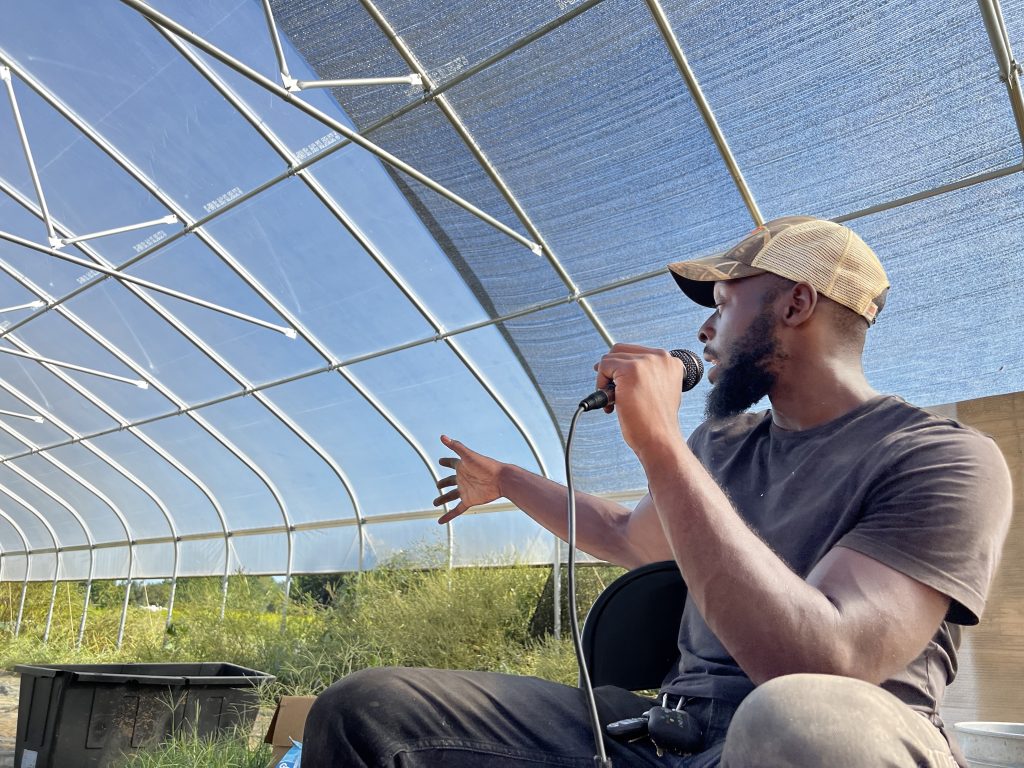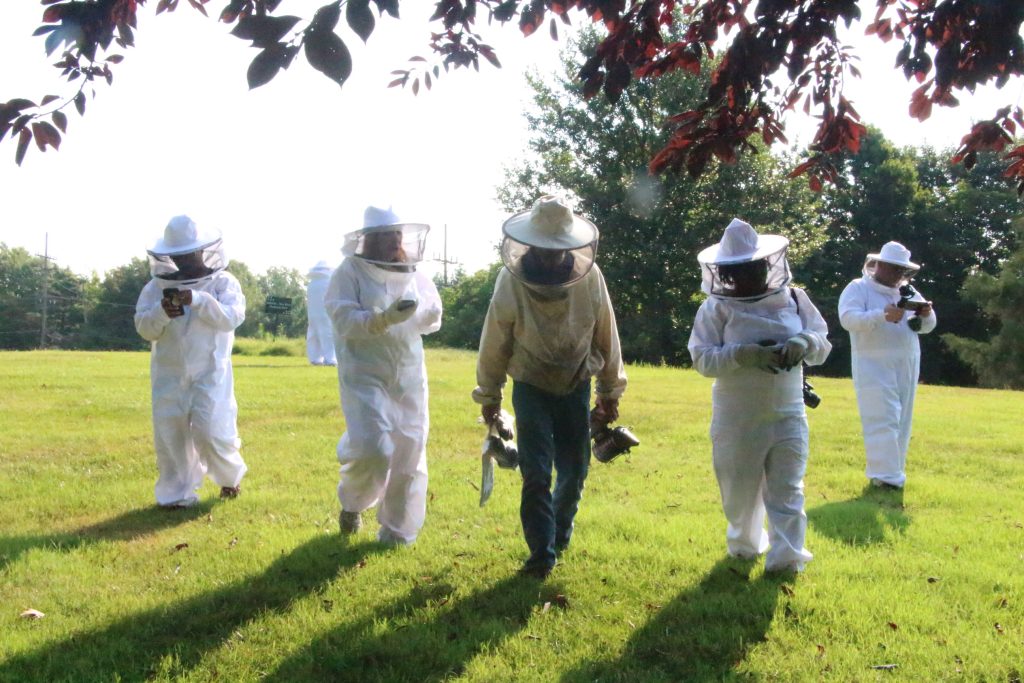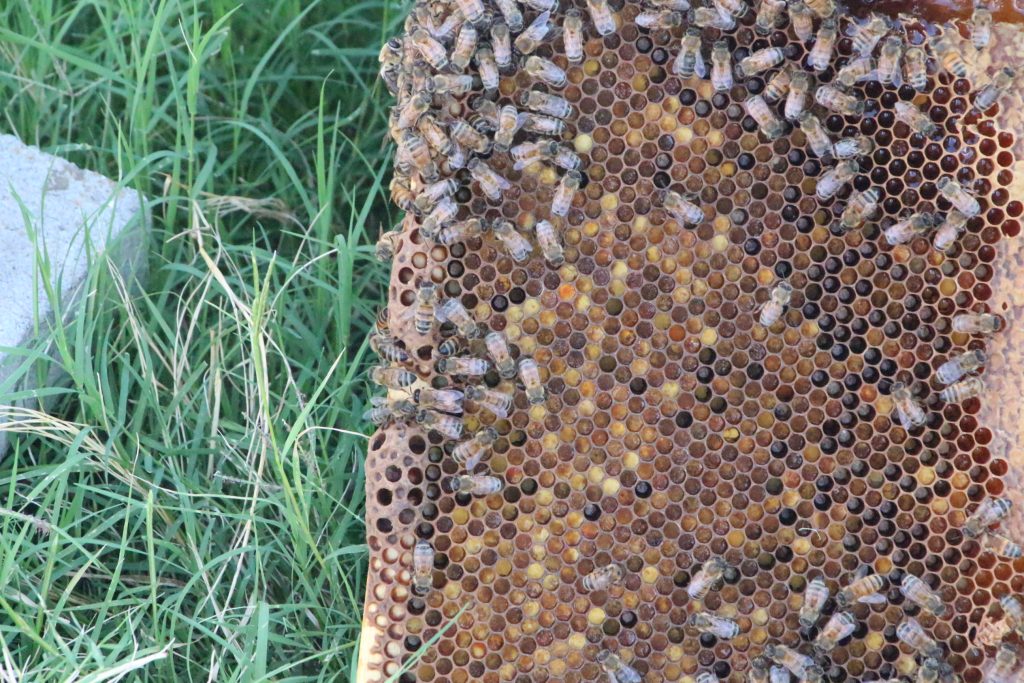Have you ever considered beekeeping as a way to building leadership skills and tapping passions? Kamal Bell has been doing just that on his first generation farm in Cedar Grove, NC. As we sat down to discuss the farm, we found chairs and space in a hot tunnel surrounded by seedlings (beets, celery, turnips, etc) to be planted soon for fall/winter harvests.
A transcript created through AI is available.
Creating Sankofa Farms
Kamal started farming relatively recently and combines it with some of his other loves. Not having family who farmed commercially, he’s had to learn along the way and tap into resources that he discovers as he goes.
He bought 12 acres in “the middle of nowhere” and has slowly been turning it into Sankofa Farms. Learning as he goes is a big piece of it. In fact, he laughed telling me that every year he seems to find something else on the property. This year he had cut down a few trees making room for greenhouses he will be installing this winter. Recently, he noticed someone picking up pecans — that tree was now visible and Kamal will enjoy getting pecans from it.
Clearing land and making the heavy clay soils more productive by introducing compost is hard work. The rewards of seeing so much food harvested and making a difference in the community makes the commitment to growth possible.
Why beekeeping?
While we sat in the hot tunnel for the interview, occasionally gees and other flying insects came by. It was clear then that Kamal and I shared a fear of getting stung! My fear was left unchecked for years but eventually, I faced it visiting a beehive with a colleague who was an expert.
I had to wonder how Kamal had grown such deep beekeeping skills!
Kamal worked as a teacher for a while and decided to go back to graduate school and study agriculture. With a passion for teaching, he has found ways to incorporate that into the farm’s mission. One of the students in the academy he created to bridge in-school learning with personal development was captivated by honey bees and made a good case for having bees on the farm. Kamal says seeing how interested the guy was, he just had to do it. And there’s been no looking back.
As you study bees more, you learn about the role bees play in their community. How they take care of the community keeping it clean, defending it against outsiders and more. The lessons were a total fit for life!
The lessons are so interesting that they’ve drawn Kamal’s middle son Akeem in whole-heartedly. A short video of the younger Bell outfitted and beekeeping went viral on Twitter this summer.
https://twitter.com/SankofaFarms/status/1549121806572863489?s=20&t=6PC_vzKFdi38luwRnrnxBw
Learning about bees seems to be contagious. I remember taking Natasha Nichols (you may remember her episode on the We Sow We Grow urban farm) out to some beehives a few years ago when I had a day job. Kamal has seen that passion a lot and encourages it. In fact, he briefly mentions in the interview about the Bees in the TRAP experience he offers via Air BnB. Since the bees are entering their downtime, he’s not got openings, but the reviews show he’s got a great experience for individuals or groups. Betting once spring comes around I have some friends ready to get geared up!
What bees do what work in the hive?
Beehives have just a few kinds of bees in them and it’s really important to the life of the hive that each does their work.
You can find hives that are just one box or beekeepers can have a colony with several boxes stacked together. No matter the size, there will only be one queen in there. Even if there are bees in the tens of thousands! The rest are workers or drones:
- Females are the workers who leave the hive for pollen, make the honey. All beekeepers seem to point out that women doing all the work seems more common than it should outside of hives too.
- Male drones stay in the hive to mate. That’s it. They will create a cyclone for the queen to come through fertilizing so that the next generation comes along. But after that, drones die. They do nothing else.
The bee larvae is sealed in a waxy area of the hive. That’s in the wooden frames that are constant in beekeeping. You frequently see pulled out for demonstration or for a beekeeper to inspect when checking on hive health. It takes 21 days for a bee to come to life. The drones are bigger than females, they don’t have stingers, and look a bit different than we are used to. After all, we are used to seeing females only.
The Bee Love Doesn’t Have to Stop Here
Knowing how many friends and family are intrigued by bees, growing vegetables, etc. I absolutely encourage you to follow Kamal at @SankofaFarms on Instagram. He’s does an incredible job with how to videos as we discuss in the episode. You can also find Kamal on LinkedIn and the farm’s website, which offers CSA memberships and more. Kamal is also on Twitter as @SankofaFarms but as he said in the interview, he’s not there as much as he is some of the other places. And we’d love for you to follow Grounded by the Farm on social media too!
We discussed a bit of the other types of bees and how some have simple houses you can make yourself. This is especially easy since paper straws have become more common. My friend Fadra and her son made these bee houses years ago, the directions are clear and I love the photos. This bee house works for native bees.
Finally, a few quick clips from our visit… next time I plan to visit longer!





